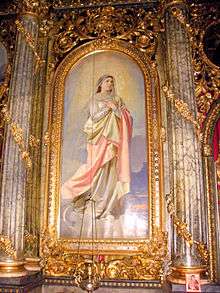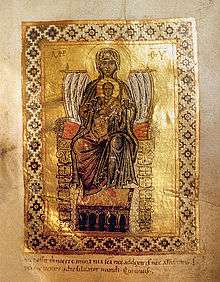Conception of the Virgin Mary

The Feast of the Conception of the Virgin Mary is the feast name given in the Tridentine Calendar on 8 December. In the present General Roman Calendar, the feast is called the Solemnity of the Immaculate Conception of the Blessed Virgin Mary. In the Eastern Orthodox Church, the holy day was once called the Feast of Conception of Saint Anne.
In the Eastern Orthodox Church, the faithful celebrate a liturgical feast on 9 December called the Conception (passive) of the Mother of God, which used to be more often called the Feast of the Conception (active) of Saint Anne.[1] The Eastern feast is not ranked among the Great Feasts, but as a lesser-ranking feast.

Unlike the Latin Church date of 8 December for the feast, the Eastern feast is not exactly nine months before the feast of the Nativity of the Theotokos (8 September), but a day later.
While the Eastern Orthodox Church recognizes the exceptional holiness of the Mother of God, whom it celebrates as immaculate (achrantos), "it did not follow the path of Roman Catholicism in moving towards a recognition of her Immaculate Conception".[3]
The Eastern Orthodox Church, which does not follow the Roman Catholic view of the Immaculate Conception, proclaimed in 1854 that while the Blessed Virgin Mary was free from personal sins in her earthly lifetime, she herself was not exempted from the Original Sin committed by Adam and Eve in the Garden of Eden.[4][5] This is because the Orthodox Church rejects the notion that the guilt of the sin of Adam and Eve is passed on to all humanity. Eastern Orthodox theologian Father Thomas Hopko explains:"The Orthodox Church, particularly in the present time, does not call the feast of Mary's beginning the "immaculate conception," although perhaps in ancient times this title would have been fully acceptable. This is not because the Orthodox consider Mary's conception to have been somehow "maculate" or "stained" (macula means "stain" in Latin). It simply means that the Orthodox do not want to support the conviction that God had somehow to intervene at the moment of Mary's conception with a special action to remove the "stain" of the original sin transmitted by the act of human reproduction because, simply put, the Orthodox do not hold that such a "stain" exists.
The Orthodox Church affirms original sin. Orthodox theology teaches that all human beings, including the Virgin Mary who is a "mere human" like the rest of us—unlike her Son Jesus who is a "real human" but not a "mere human" because He is the incarnate Son and Word of God—are born into a fallen, death-bound, demon-riddled world whose "form is passing away" (1 Cor 7:31). We are all born mortal and tending toward sin. But we are not born guilty of any personal sin, certainly not one allegedly committed "in Adam." Nor are we born stained because of the manner in which we are conceived by the sexual union of our parents. If sexual union in marriage is in any sense sinful, or the cause in itself of any sinfulness or stain, even in the conditions of the "fallen world," then, as even the rigorous Saint John Chrysostom has taught, God is the sinner because He made us this way, male and female, from the very beginning. ... Mary is conceived by her parents as we are all conceived. But in her case it is a pure act of faith and love, in obedience to God's will, as an answer to prayer. In this sense her conception is truly "immaculate." And its fruit is woman who remains forever the most pure Virgin and Mother of God. Come, let us dance in the spirit! Let us sing worthy praises to Christ! Let us celebrate the joy of Joachim and Anna, The conception of the Mother of our God, For she is the fruit of the grace of God. " - Fr. Thomas Hopko: The Winter Pascha: Chapter 9
See also
- The Blessed Virgin Mary
- Immaculate Conception
- Feast of the Immaculate Conception
- Theotokos Panachranta
- Dormition of the Virgin
- Assumption of the Virgin
- The Original Sin of Adam and Eve
References
- ↑ Extract from Francis X. Weiser, The Holyday Book (Harcourt, Brace and Company, Inc., New York 1956)
- ↑ Raymond Burke, 2008, Mariology: A Guide for Priests, Deacons,seminarians, and Consecrated Persons Queenship Publishing ISBN 1-57918-355-7 page
- ↑ John Anthony McGuckin, The Orthodox Church: An Introduction to Its History, Doctrine, and Spiritual Culture (Blackwell 2011 ISBN 978-1-4443-3731-0), p. 218.)
- ↑ http://www.antiochianarch.org.au/Orthodox-view-on-Immaculate-Conception.aspx
- ↑ http://orthodoxinfo.com/inquirers/theotokos.aspx